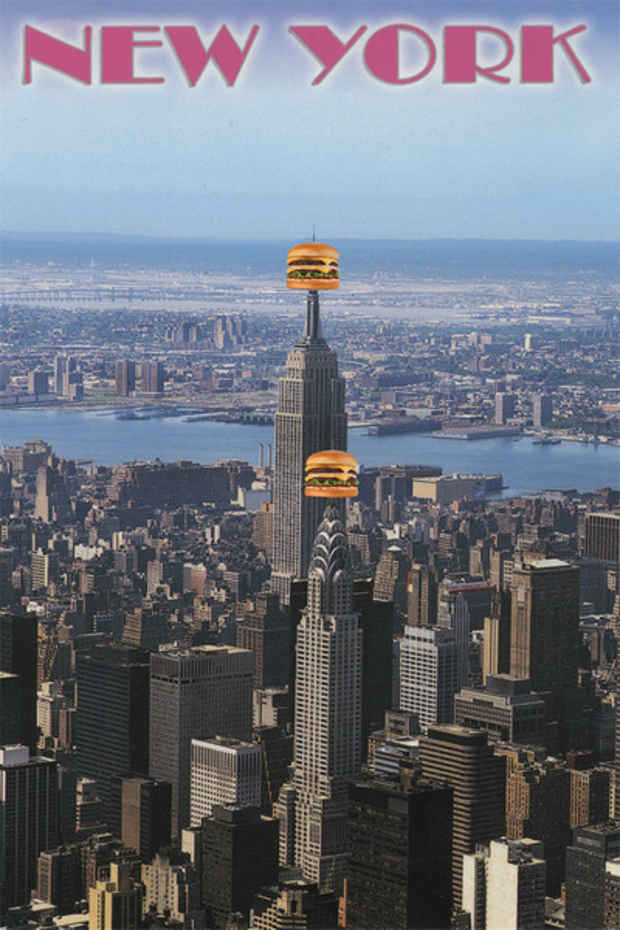Mamiko Otsubo “Sky Lobby (CE!)”
Cleopatra's

This event has ended.
Text by Robert Rhee
Standing in a subway car at the very middle of the Manhattan Bridge I punched this phrase into my phone: installed sculpture is indentured too. I looked around the car and through the windows up and down the river. A woman sat and read the Times folded into long quarters. A man, headed for midtown, stood with his back against the door. Everyone was listening to different music and in the precious silence I hung a little off the center pole.
It should come as no surprise to those who ride the B train that we were not bounding across bridge but stopped, waiting for instructions from the train’s dispatcher. In fact we were suspended there for fifteen minutes and no one seemed to mind, by which I mean no one’s father, friend, child, co-worker, spouse or significant other had a total solo meltdown.
I remembered this moment on the train when Mamiko told me her title, Sky Lobby. I pictured my stop on the bridge as if it were a place: A place embedded not in the landscape but in the motion of the train, or in this case its immobility. Below the phrase above, I wrote as well: not to change the rules but to change the play – this is Mamiko’s style.
In the lead up to this show Mamiko spent months moving works around a scale model of the gallery. After some time and much frustration she realized that this was exactly what she was trying to avoid in making sculpture—thinking in the language of composition. Along these lines, this exhibition references and serves as a counterpoint to late Minimalist works such as Carl Andre’s Eight Cuts and Walter De Maria’s The Broken Kilometer, which deal with the problem of part by part composition by addressing the entire floorplan of the exhibition space as if it were itself a frame. These references, however, are demonstrative of how the works pivot and how they play, for their main interest is not the exploration of the frame as a border but as an artificial meeting place.
The 3 high-polished brass poles with patina burger buns, BP I, II, & VII, which strike down at evenly spaced intervals throughout the gallery are designed to be adjustable in height, in order to accommodate different kinds of spaces and ceiling heights. The distance between the poles, however, is predefined by a 12’ x 12’ matrix that extends past the present floor plan in all directions. Thus the relationship between the poles remains constant, in humorous obliviousness to the exhibition space as a frame that demands individualized attention.
In the stone wall-pieces the combination of stone and of lettering is meant to call to mind common pairings of materials in skyscraper facades. The specific text in these works are commercial hamburger names chosen for their sculptural qualities. Reminiscent of Gertrude Stein’s evocation of the double life of objects, and most notably words, Mamiko treats these names as if they were both descriptions and sculptural materials.
The resultant works are strangely authoritative absurdities whose co-presence, with each other and the exhibition site, is distinctly virtual. In a sense, each work is a slice of something that continues on, an instance accompanied by the proposition of its expansion. As a whole they are architectural paradoxes that added up find no sum, no possibility of wholeness, but instead the same relationship with the same parts now rearranged. These abrupt moves call for a prolonged reading of her abstractions.
Robert Rhee is an artist and writer, living and working in Seattle and New York.
The artist would like to thank Lullin + Ferrari and Statens Værksteder For Kunst / Danish Art Workshops for their support of the exhibition.
¹ (CE!) in the show’s title speaks to this relationship of disparate physical sites linked by a shared virtual standards. (CE!) or Copy Exactly! is a methodology developed and implemented by Intel which “focuses on matching the manufacturing site to the development site. Matching occurs at all levels for physical inputs and statistically-matched responses (outputs).”
So no matter if you are at D1X in Hillsboro, Oregon, or Fab 28 in Kiryat Gat, Israel, or Fab 68 in Dalian, Liaoning, China if you are on the production floor everything from the orientation, to the height, size, material, etc. of everything around you will be exactly the same. Read more about it here: http://www.intel.com/content/www/us/en/quality/exact-copy.html
Media
Schedule
from April 26, 2015 to May 31, 2015
Opening Reception on 2015-04-26 from 19:00 to 21:00